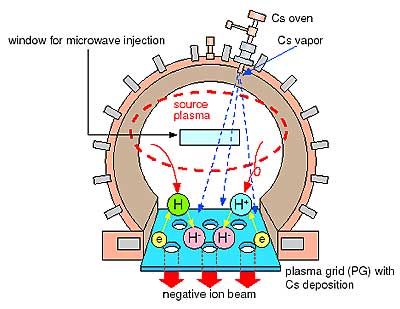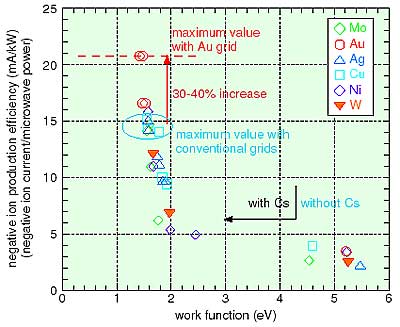Cesium (Cs)-seeded negative ion sources (hydrogen or deuterium) have been
already operated in neutral beam injection (NBI) systems for heating and current
drive in fusion plasmas. The negative ion current is increased by seeding a small
amount of Cs into the negative ion source. This is mainly caused by the enhancement
of the surface production (H, H+ + e-> H-). Namely, the work function of the
plasma grid (PG) facing the source plasma is lowered by Cs deposition, resulting
in the enhancement of the surface production of negative ions. This effect suggests
that the negative ion production efficiency can be improved further by lowering
the work function of the PG.
It has not been known which PG material gives the lowest work function by seeding Cs in the negative ion source. As shown in Fig.
3-7, the negative ion production efficiency, defined as the beam current divided by the input discharge power, was compared for various PG materials in a negative ion source (semi-cylindrical shaped; 340 mm in length and 340 mm in diameter) by driving the discharge with microwave.
To choose the PG materials, various metal pieces were tested in the negative ion source by measuring the photoelectron current emitted from the surface under laser irradiation. When the work function is lower, the photoelectron current becomes higher. The materials which have higher inherent work function, such as gold (Au), nickel (Ni) and silver (Ag), showed high photoelectron current by seeding Cs. Thus it is expected that Au, Ni and Ag have the lower work function by seeding Cs.
The six PG materials, namely Au, Ni, Ag, and the conventional grid materials of copper (Cu), molybdenum (Mo) and tungsten (W), were used in the measurements of negative ion production efficiency and work function. Fig. 3-8 shows the correlations between the work function and the negative ion production efficiency for various PG materials. The Cs coverage on the PG surface was controlled by changing the temperature of the PG so as to determine the lowest work function for each material. Au and Ni showed lower work functions and higher negative ion production efficiencies than the conventional PG materials. It was found that the negative ion production efficiency depends only on the work function for the different PG materials. The highest negative ion production efficiency of about 30-40% larger than that with conventional PGs was obtained with an Au grid (3 micrometer thickness of Au plated on a Mo substrate) whose work function was lowered to 1.44 eV by seeding with Cs. It is expected that these results will contribute to the development of high efficiency negative ion sources. |

